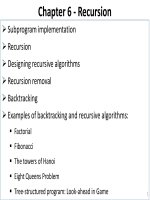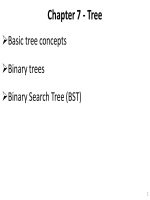Data Structures and Algorithms – C++ Implementation ppt
Bạn đang xem bản rút gọn của tài liệu. Xem và tải ngay bản đầy đủ của tài liệu tại đây (167.88 KB, 53 trang )
Data Structures and Algorithms –
C++ Implementation
Ho Chi Minh City University of Technology
Faculty of Computer Science and Engineering
BK
TP.HCM
BK
TP.HCM
Huỳnh Tấn Đạt
Email:
Home Page: />Pointer in C++
Declaration
Node *ptr;
Create an object
ptr = new Node();
A pointer usage
printf
(“Data in node: %d”,
ptr
-
>data);
ptr
ptr
???
Slide 2Faculty of Computer Science and Engineering – HCMUT
printf
(“Data in node: %d”,
ptr
-
>data);
Destroy an object
delete ptr;
NULL pointer
ptr = NULL;
ptr
???
ptr
Pointer in C++
Be careful in these cases:
ptr1
ptr2
Before
ptr1 = ptr2;
Before
delete ptr1; ptr1 = NULL;
ptr1
ptr2
Slide 3Faculty of Computer Science and Engineering – HCMUT
After
ptr1 = ptr2;
ptr1
ptr2
After
delete ptr1; ptr1 = NULL;
ptr1
ptr2
Garbage
Dangling reference problem
Parameter Passing Techniques
void func(int* a, int* b){
int *t;
t = a;
a = b;
b = t;
}
void main() {
int *p1 = new int;
*p1 = 10;
int *p2 = new int;
*p2 = 20;
func(p1, p2);
printf
(“%d”,
*
p1);
Slide 4Faculty of Computer Science and Engineering – HCMUT
}
void func(int* &a, int* &b){
int *t;
t = a;
a = b;
b = t;
}
printf
(“%d”,
*
p1);
printf(“%d”, *p2);
}
Parameter Passing Techniques
void func(int* &a, int* b){
int *t;
t = a;
a = b;
b = t;
}
void main() {
int *p1 = new int;
*p1 = 10;
int *p2 = new int;
*p2 = 20;
func(p1, p2);
printf
(“%d”, *p1);
Slide 5Faculty of Computer Science and Engineering – HCMUT
}
void func(int* a, int* &b){
int *t;
t = a;
a = b;
b = t;
}
printf
(“%d”, *p1);
printf(“%d”, *p2);
}
Parameter Passing Techniques
void func(int **a, int **b){
int *t;
t = *a;
*a = *b;
*b = t;
}
void main() {
int *p1 = new int;
*p1 = 10;
int *p2 = new int;
*p2 = 20;
func(&p1, &p2);
printf
(“%d”, *p1);
Slide 6Faculty of Computer Science and Engineering – HCMUT
}
printf
(“%d”, *p1);
printf(“%d”, *p2);
}
Linked Lists
A linked list is an ordered collection of data in which each
element contains the location of the next element
Element = Data + Link
head data link
Slide 7Faculty of Computer Science and Engineering – HCMUT
empty
linked list
Nodes
number name
A node with
one data field
number
A node with
three data fields
id
Slide 8Faculty of Computer Science and Engineering – HCMUT
name numberid
A node with one
structured data field
Nodes
Linked List
Structure
count
head
list
count <integer>
Data node
structure
data link
node
data <
dataType
>
dataType
key <keyType>
Slide 9Faculty of Computer Science and Engineering – HCMUT
count <integer>
head <pointer>
end
endend
end list
data <
dataType
>
link <pointer>
end
endend
end node
key <keyType>
field1 <…>
field2 <…>
…
fieldN <…>
end
endend
end dataType
Nodes – Implementation in C++
struct Node {
int data;
Node *next;
};
node
data <dataType>
link <pointer>
end node
Slide 10Faculty of Computer Science and Engineering – HCMUT
Nodes – Implementation in C++
Node *p = new Node();
p->data = 5;
cout<< p->data;
Node *q = p;
cout<< q->data;
Node *r = new Node();
p
5
q
10
Slide 11Faculty of Computer Science and Engineering – HCMUT
Node *r = new Node();
r->data = 10;
q->next = r;
cout<< p->next->data;
r
10
Nodes – Implementation in C++
struct Node {
int data;
Node *next;
};
struct Node {
float data;
Node *next;
};
Slide 12Faculty of Computer Science and Engineering – HCMUT
template <class ItemType>
struct Node {
ItemType data;
Node<ItemType> *next;
};
Nodes – Implementation in C++
Node<int> *p = new Node<int>();
p->data = 5;
cout<< p->data;
Node<int> *q = p;
cout<< q->data;
Node<
int
> *r = new Node<
int
>();
p
5
q
10
Slide 13Faculty of Computer Science and Engineering – HCMUT
Node<
int
> *r = new Node<
int
>();
r->data = 10;
q->next = r;
cout<< p->next->data;
r
10
Nodes – Implementation in C++
template <class ItemType>
class Node{
public:
Node(){
this->next = NULL;
}
Node(
ItemType
data){
Slide 14Faculty of Computer Science and Engineering – HCMUT
Node(
ItemType
data){
this->data = data;
this->next = NULL;
}
ItemType data;
Node<ItemType> *next;
};
Linked List – Implementation in C++
template <class List_ItemType>
class LinkedList{
public:
LinkedList();
~LinkedList();
protected
:
list
count <integer>
head <pointer>
end list
Slide 15Faculty of Computer Science and Engineering – HCMUT
protected
:
Node<List_ItemType>* head;
int count;
};
Linked List Algorithms
Create list
Insert node
Delete node
Traverse
Destroy list
Slide 16Faculty of Computer Science and Engineering – HCMUT
Linked List Implementation
template <class List_ItemType>
class LinkedList{
public:
LinkedList();
~LinkedList();
protected:
int InsertNode(Node<List_ItemType>* pPre,
List_ItemType value);
List_ItemType
DeleteNode
(Node<
List_ItemType
>*
pPre
,
Slide 17Faculty of Computer Science and Engineering – HCMUT
List_ItemType
DeleteNode
(Node<
List_ItemType
>*
pPre
,
Node<List_ItemType>* pLoc);
int Search(List_ItemType value, Node<List_ItemType>*
&pPre, Node<List_ItemType>* &pLoc);
void Traverse();
Node<List_ItemType>* head;
int count;
};
Linked List Implementation
template <class List_ItemType>
class LinkedList{
public:
LinkedList();
~LinkedList();
void InsertFirst(List_ItemType value);
void InsertLast(List_ItemType value);
int InsertItem(List_ItemType value, int Position);
List_ItemType
DeleteFirst
();
Slide 18Faculty of Computer Science and Engineering – HCMUT
List_ItemType
DeleteFirst
();
List_ItemType DeleteLast();
int DeleteItem(int Postion);
int GetItem(int Position, List_ItemType &dataOut);
void Print2Console();
void Clear();
// Augment your methods for linked list here!!!
LinkedList<List_ItemType>* Clone();
protected:
//
Linked List Implementation
How to use Linked List data structure?
int main(int argc, char* argv[]) {
LinkedList<int>* myList =
new LinkedList<int>();
myList->InsertFirst(15);
myList->InsertFirst(10);
myList
-
>
InsertFirst
(5);
Slide 19Faculty of Computer Science and Engineering – HCMUT
myList
-
>
InsertFirst
(5);
myList->InsertItem(18, 3);
myList->InsertLast(25);
myList->InsertItem(20, 3);
myList->DeleteItem(2);
printf("List 1:\n");
myList->Print2Console();
Linked List Implementation
//
int value;
LinkedList<int>* myList2 = myList->Clone();
printf("\nList 2:\n");
myList2
-
>Print2Console();
Slide 20Faculty of Computer Science and Engineering – HCMUT
myList2
-
>Print2Console();
myList2->GetItem(1, value);
printf(“Value at position 1: %d”, value);
delete myList;
delete myList2;
return 1;
}
Create List
Before
list.head = null
list.count = 0
?
?
count
head
list
Slide 21Faculty of Computer Science and Engineering – HCMUT
0
count
head
After
list
list.count = 0
Create List
Algorithm createList (ref list <metadata>)
Initializes metadata for a linked list
Pre list is a metadata structure passed by reference
Post metadata initialized
1 list.head = null
2
list.count
= 0
Slide 22Faculty of Computer Science and Engineering – HCMUT
2
list.count
= 0
3 return
End createList
Linked List Implementation
template <class List_ItemType>
LinkedList<List_ItemType>::LinkedList(){
this->head = NULL;
this->count = 0;
}
Slide 23Faculty of Computer Science and Engineering – HCMUT
Insert Node
Allocate memory for the new node and set up data
Point the new node to its successor
Point the new node's predecessor to it
Slide 24Faculty of Computer Science and Engineering – HCMUT
Insert into Empty List
Before
0
count head
list
pNew
-
> link = list. head
75
pNew
Slide 25Faculty of Computer Science and Engineering – HCMUT
After
pNew
-
> link = list. head
list.head = pNew
1
count head
list
75
pNew









